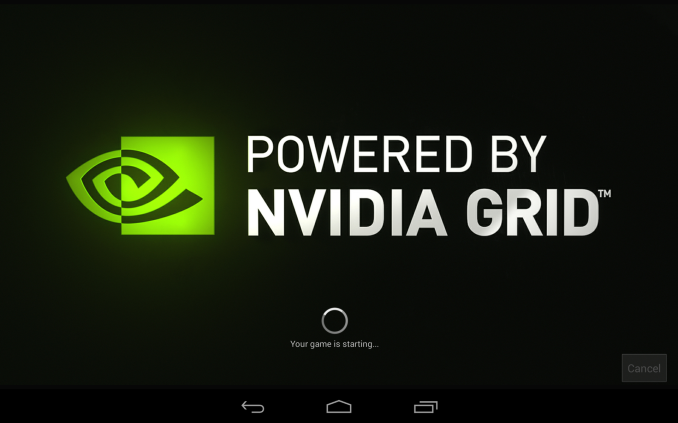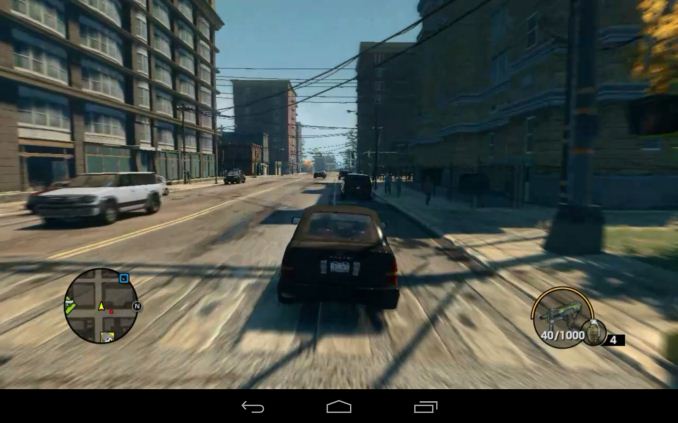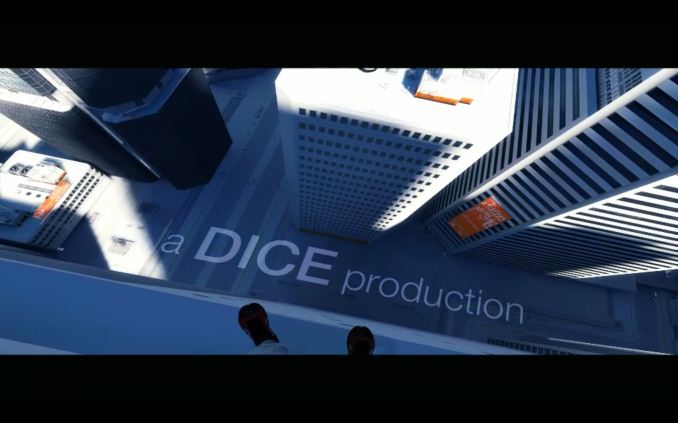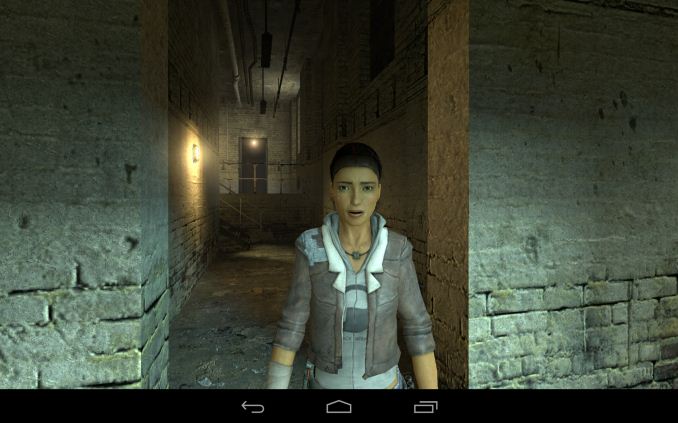The NVIDIA SHIELD Tablet Review
by Joshua Ho on July 29, 2014 9:00 AM ESTGameStream and GRID
The final software features that Shield Tablet brings to the table are GameStream and GRID. These are effectively methods of turning the tablet into a thin client, as all of the rendering/computation is done on a computer either in the LAN or on a server in San Jose. From a technical perspective, both work great as long as the connection has high bandwidth and low latency. For GRID, I managed to get a great user experience on a symmetrical 10 Mbps connection and around 10ms latency to the server. Games like Saints Row 3 played as if running on a console when the device is actually streaming from NVIDIA servers. From the user’s perspective, it’s a matter of going into the app drawer, opening GRID, and selecting a game. It’s simple and given sufficient server coverage I could easily see a Netflix-style usage model taking off quite successfully.
Although I didn’t spend as much time with GameStream, I didn’t detect any input lag and for the most part it’s just as simple. As long as a GameStream-enabled PC is on the same network, accessing GameStream compatible games is just a matter of going to the Shield Hub application, entering a four digit code on the PC to pair it with the tablet, and selecting a game. GameStream also works remotely, but the same caveats that come with GRID apply to GameStream on both the server and client end. Of course, the games that will run on GameStream have to be carefully selected. While it’s fully possible to play a twitch shooter like Call of Duty through GameStream, trying to use a controller in multiplayer is simply a massive disadvantage against people that are competent with a mouse and keyboard. I've included a screenshot of Mirror's Edge that I took while testing GameStream.
Gaming Ecosystem
Ultimately, I’m a bit conflicted on whether GameStream and GRID are really designed to stand on their own though. GameStream only works while you’re at home, and GRID is highly dependent upon low latency and also needs around 10 Mbps download and 5 Mbps upload for an ideal experience. Due to the latency requirement and the fact that the only GRID server bank is in San Jose, the very low latencies that GRID is best suited for are generally only achievable in California and parts of other nearby states. They’re definitely great in the situations that they work, but ultimately the native game library has to stand alone. To this end, the tablet is in a far better situation than the original Shield. The number of games that provide a quality gaming experience is now leaps and bounds better than what we saw with the launch of the Shield Portable. Trine 2 is included out of the box, and while I didn’t get a chance to try co-op mode it’s a compelling experience that once needed GameStream or GRID to be played on Shield. Along the same lines, the Grand Theft Auto series, Half Life 2, and Portal all play surprisingly well.
Fundamentally though, I don’t think single player games alone will sell Shield as a gaming platform. A single player game can only have a certain amount of replay value. Something like Half Life 2 might have 12 hours of gameplay at best. In comparison, multiplayer has massive amounts of replay value because even the same map can play out differently depending upon the people that play in the round. It’s that factor that makes it possible for people to spend 1200 hours playing a game like Battlefield 2. Unfortunately, for the most part the Shield tablet has a game library that seems to be skewed towards single player games. Fortunately, NVIDIA seems to understand this. While I haven’t been able to play War Thunder on Shield tablet, the promise of compelling multiplayer games on this device would be a strong enough reason to excuse potential shortcomings in other areas. Although it's good that an immersive multiplayer title is coming to Shield tablet, the key point of emphasis is that people playing a Shield device can play with those on console or PC as well. Until NVIDIA hits critical mass for Shield device adoption, multiplayer titles that only allow people on Shield to play with others on Shield will struggle because people won't play multiplayer unless there are other people to play with.















174 Comments
View All Comments
fivefeet8 - Tuesday, July 29, 2014 - link
Those arguments are the same ones made with the advent of gaming laptops and desktops. I can agree that the market for both is in the minority, but something needs to push the technology forward. At this point, the mobile space is ruled mostly by companies with technologies both hardware and software that have stagnated. Mostly because of the market conditions leaving pretty much only Qualcomm technology, but that has also caused them to become complacent to a large degree when it comes to software.schizoide - Tuesday, July 29, 2014 - link
Not really. Back in the day, games drove PC gaming hardware. You would go out and buy that new 3dfx card to play Quake 2. These days most PC games are console ports and low to mid-end hardware can play them just fine.Difference is that today there's an incredibly huge market full of mobile games with very modest hardware requirements, and very few are willing to release titles requiring top line hardware because the perception is those "core" gamers have consoles or gaming PCs.
You're right that if nobody builds mobile devices with higher-end capabilities those games will _certainly_ never come. That's dead on. But at the same time, I'm not going to buy a gaming device without an exclusive game that I really want. And 10 year old PC ports like portal don't cut it.
fivefeet8 - Tuesday, July 29, 2014 - link
That's the same argument you are making against the Shield Tablet. That it's hardware is not needed because most games run fine on lesser powered machines. Software has been playing catchup to PC hardware for years now, but we still have high end hardware to push the envelope.In any case, with the new Shield is a tablet that can do more than most on the market right now while still being able to push the technology forward. And you are correct, I wouldn't buy a gaming device either without a few games I really want, but then I'm not buying it simply for a gaming device only.
savagemike - Tuesday, July 29, 2014 - link
You might not buy a gaming device in that scenario. But this isn't just a gaming device it's also a tablet and as such can fill multiple uses.I'm not positive I'm going to buy one but I might. It's definitely on the list for consideration because it is so flexible. I wanted an 8"+ tablet and would very much like a stylus. Wasn't digging the extra price of the Samsung stylus models though.
For $300 this thing seems like it does lots of stuff pretty well. I would be surprised if there are not bundles for $325 or so that include the tablet and controller come the holidays.
We'll see. Want to see what the 64x version looks like too and also how pricing and quality play out for Android TV.
ArthurG - Tuesday, July 29, 2014 - link
comparing refurb price of a 6 months old item to a brand new model coming out today, very very fair...schizoide - Tuesday, July 29, 2014 - link
Sure. Why not? Money is money. You want to buy a small android tablet, Nexus 7 is at the top of your list, right?Friendly0Fire - Tuesday, July 29, 2014 - link
A lot of people don't consider refurbs. I know I don't.schizoide - Tuesday, July 29, 2014 - link
Fair enough, then it's only a 25% price premium. Certainly much more attractive, then.abrowne1993 - Tuesday, July 29, 2014 - link
The biggest problems I have with my 2013 Nexus 7 are CPU and GPU performance. If I didn't already have that tablet, I'd buy this one in a heartbeat.TheJian - Wednesday, July 30, 2014 - link
You must be kidding, comparing a refurb of an AGING product to a new product? $230 is the comparison, and for $70 extra you kick the crap out of nexus 7 2013. I didn't realize $300 was 2x $230. I guess I failed math.All the new games that come along with 20nm will likely have problems on that old thing, where K1 will keep on chugging (K1 will be the lowest common denominator next year at 20nm everywhere, and M1 or whatever they call maxwell version will be the new king). Not really interested in running all the games that are built for the lowest common denominator that will run on your aunt's galaxy s2. I'm interested in modern combat 5, asphalt 8, Ravensword, Dungeon Hunter 4 etc. All the stuff coming out this year and forward will get more potent. Though the old stuff is pretty nice too. The library keeps getting larger on android monthly.
Will they sell a lot of them? Tell that to google, they'll be using K1 in HTC Nexus 9. I'm guessing 10mil+ sell in that unit alone and it will probably be $400-500 ;) $300 for a tablet that blows everything else in it's class away is cheap. Get off welfare, get a better job etc and $300 won't sound like much more than $230...ROFL.
One of the other reviews did fine from North Dakota 1600 miles from California ;) Troll somewhere else please. Most of the ports have never sold more than 11mil (halflife2, Portal, Trine2 etc) so most people have never played the ports you're hating on. There are 1.2B android devices sold yearly now and growing. Next year with 20nm chips being at K1 level there will be 1.2B+ units top to bottom that can handle what K1 is doing and that will be what will create major game improvements. Everyone will be holding an Xbox360/ps3 in their hands that can act as a console output to tv. We're not talking angry birds any more even today. BTW, Trine2 came out 2011, Serious Sam3 BFE 2011, Portal 2008. We will start to see even more now especially after HTC Nexus9 hits. Not to mention companies like Gameloft, WB etc creating some top level stuff.